High on the mountain . . . winds a blowing free . . . standing all alone
. . .wondering where the days of my life have gone.
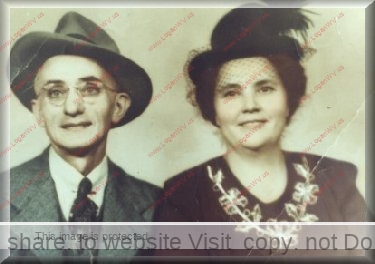 Augusto “Patsy” Tobia & Alice Virginia Burns Tobis
Augusto “Patsy” Tobia & Alice Virginia Burns Tobis
Patsy was born in Rome, Italy, and came to America at age 17 with his brother to find employment. Alice was from Hamlin in Lincoln County. They had 12 children: *Katherine, *Ruby, Louis, Naomi, *Bertha, Romie, Sylvia, Emanuel, Paul, Billy, Manford, *Jimmy (*deceased). The Tobia family lived at Dehue from 1931 to 1950. Patsy died in 1961 and Alice in 1982.
 Sam & Ocie Ojeda
Sam & Ocie Ojeda
MINER’S PRAYER
When the whistle blows each morning,
and I walk down in that cold dark mine.
I say a prayer to my dear Savior,
“Please let me see the sunshine one more time.”
When . . . oh when will it be over?
When will I lay these burdens down?
And when I die, dear Lord in Heaven,
Please take my soul from ‘neath that cold dark ground.
I still grieve for my poor brother,
And I still hear my dear old mother cry.
When late that night they came and told her,
He’d lost his life down in the Big Shoal Mine.
Miner’s Prayer was written by Dwight Yoakam in memory of his brother
who died in the Big Shoal Mine in Kentucky.
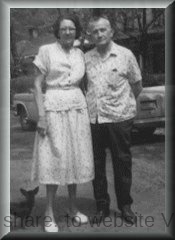 JESSIE AND ALBERT FULK
JESSIE AND ALBERT FULK
A COAL MINING MAN
by: Dolores Riggs Davis
Albert Fulk was the son of George W. and Luella B. Fulk, and the only son of nine children. He was born October 18, 1900, and began working in the coal mine at age thirteen. He worked long hours, and often worked in such low coal he had to crawl on his knees to do his job. In 1913 there were no child labor laws, and often children as young as age nine perished in mine disasters.
Albert married Jessie Marie Earle, daughter of Frank and Eliza Jane Earle in Linton, Indiana on January 17, 1925. They moved to Sullivan, Indiana where Albert went to work at the Little Betty Mine in Dugger. Albert fought hard for the organization of the union, and spent many a night in the Sullivan jail for his efforts. It was a difficult task for his wife, Jessie to explain to their three young children why their daddy was in jail.
On January 28, 1931, the Little Betty Mine exploded killing twenty-eight of Albert’s co-workers, but he was spared. The explosion was not a violent one, and covered only a small section of the mine. Little Betty was known as a gassy mine, and all the men wore open-lights on their helmets. The mine had not been rock-dusted, and coal dust caused the explosion.
Death came knocking on Albert’s door again on July 15, 1937 when the Baker Mine in Sullivan blew killing twenty men. He stayed in the mine to help recover the badly burned bodies of his friends, and sent word to his wife that he was safe. There were two blasts, and the last one was caused by a miner relighting his carbide light. However, the mine had been heavily rock-dusted at the time of the blast. Jessie went to the mine to wait for Albert after receiving the message. Albert was called Shorty because he played shortstop on the miners baseball team, and later the family joked that the last one out of the Baker Mine was Shorty and his mule.
Albert had a difficult time dealing with the Baker disaster. He sobbed and screamed, and said he could smell burned flesh on his body. He couldn’t eat for a week, and scrubbed in a number 2 wash tub sometimes three times a day. When he could keep food down, Jessie fed him as he couldn’t stand his hands near his nose. No matter how much he scrubbed his hands he couldn’t wash off the stench of death. During that time, Albert and his buddies did a lot of drinking to dull their memories of the terrible tragedy. He often woke up screaming from his nightmares. It scared the children, and they were sometimes sent to their grandmothers for the night.
After that the family moved to McDowell County, West Virginia, but in 1946 they settled at Dehue where Albert worked for the Youngstown Mining Company. In 1968 while visiting his children in Texas, Albert had emergency open-chest surgery at Houston Methodist Hospital to remove a blood clot from his lung. When he woke up in the recovery room, and began to scream and cry no one understood what was troubling him. His daughter Pat who was a nurse was called, and as soon as she entered his room she knew he was having flashbacks from the Baker Mine disaster. A burn victim was in the recovery room, and the smell caused Albert to relive the mine explosion. After thirty-seven years . . . the traumatic effects of that mine disaster were still as real to Albert as the day they happened. He was quickly moved to another room, and sedated to calm him. After that, his recovery went well. Post-Traumatic Stress Disorder, often referred to as PTSD was not labeled until after the Vietnam War. It is now a proven fact that anyone who experiences a traumatic event may be affected by PTSD.
When Albert retired from the Dehue Mine, he and Jessie bought a house at Lundale on Buffalo Creek. On February 26, 1972 after days of heavy rain a dam at Sanders broke sending a tidal-wave of water rushing down the Buffalo Creek Valley killing 125 people. Lundale was one of about 16 communities in the path of destruction. Their children, Robert and Pat rushed to the scene, and were told their parents had perished. They took on the grim task of going through body-bags, and checking toe-tags in search of their parents bodies. When they were not among the dead, Robert was flown by helicopter to his parent’s house which was one of the few left standing.
Lundale was the third mining town below Saunders. Jessie was on a walker and there wasn’t time for them to flee to the mountainside. Albert and Jessie prepared for death clinging to each other saying their goodbyes. As the black oily water picked up speed it careened like a tornado from one side of the mountain to the other leaving some houses while washing others away. A wall of water passed over their house, and Jessie said she saw bodies pass by through the glass in the door. Fifty-one people died in Lundale, but by some miracle their house withstood the force of the water sparing their lives. Jessie never liked going to the ocean after that day. The sound of the surf hitting the shore brought back memories of the flood. The cleanup crew moved their house across the railroad tracks which faced where it once stood. Albert and Jessie were never told. Robert drove by the house recently. Another family lives there, but he said the house looks like it always did.
They were told they could gather a few personal things to take with them. Jessie selected their medications, false teeth, family pictures, and a Bible. Albert chose the title to the house which they would never see again, the title to the car which was a total loss . . . and a small green book called Mine Safety Rules Book of Approved Rules – May 7, 1935. He later gave the book to Pat telling her one day she may need it. Pat couldn’t believe she could laugh when she told me the story. Fate was cruel to Albert at times, but through it all he was still a coal mining man.
After the loss of all their possessions Albert and Jessie moved in with daughter, Pat in Splendora, Texas where they lived for three years before moving to nearby Elkhart. Jessie passed away in 1975, and was brought back to West Virginia for burial. Albert died in 1994 and was buried in Texas. They left behind children Billie Ann, Patricia Louise, Robert Nelson, and AlbertNelson, Jr., ten grandchildren and a host of great-grandchildren. This information and picture are the courtesy of daughter Pat Staley.
INSIDE STIRRAT MINE # 4 MINE – ca 1936
photo by: Frank B. Snyder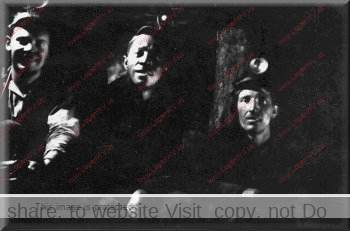
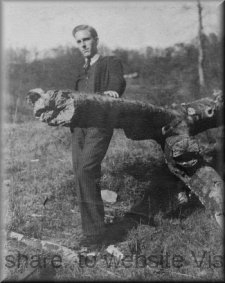 Frank B. Snyder
Frank B. Snyder
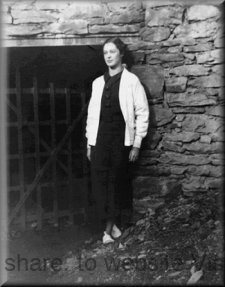
Oralee Baldwin Snyder at the Stirrat mine shaft
OMAR AND STIRRAT DOCTORS AND NURSES
Employed by West Virginia Coal and Coke Company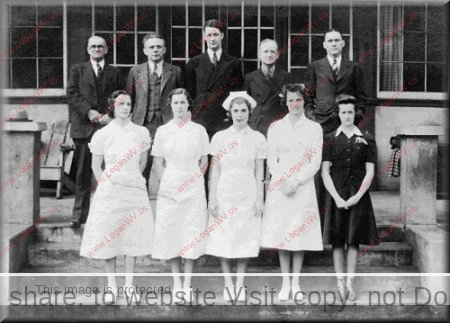 front row: Nurses – Mary Payne Logan, Oralee Baldwin Snyder, Mrs. Kiraly, Elizabeth Doll Tucker, Secretary – Margaret Gresham
front row: Nurses – Mary Payne Logan, Oralee Baldwin Snyder, Mrs. Kiraly, Elizabeth Doll Tucker, Secretary – Margaret Gresham
back row: Dr. Aultz, Dr. Dana T. Moore, Dr. “Lefty” Lovejoy, Dr. B.D. Smith, Dr. Starcher
DEHUE FAMILY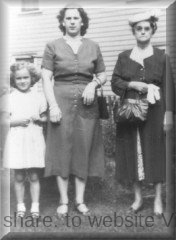 Joyce Floyd, Gay Floyd & Carrie Biggs – 1950
Joyce Floyd, Gay Floyd & Carrie Biggs – 1950
DALTON GROCERY – ONCE LOCATED AT PHICO ON RT. 10 owner T.F. Dalton
owner T.F. Dalton
photo by grandson, Bill Dalton – May 1954

Nurse Mary Logan was born in 1920 in Slab Fork Raleigh County WV. Her parents were Charles – 1891- 1974 and Mary –
1892- 1985 Logan. Charles was the Foreman at the Slab Fork Coal Company for many years. Charles and Mary were married in 1917 in Norfolk,VA. Mary Logan enlisted in the Army Womens Nurse Corps on June 8, 1945 and she served in the Pillippines in WWII. In 1970 Mary married Raymond Chase – 1926-2013. Mary died in 1999 in Tucson Az.
In the Omar and Stirrat Doctors and Nurses Photo the 1940 census shows the Secretary Margaret Gresham working at the Hatfield and Lawson Hospital. She was born in 1920 in Logan and died in 2010 in Logan. Her father was Oscar Gresham 1895- 1965 and her mother was Margaret Gresham ( Gunning ) 1896- 1977. They were married in 1917 and Oscar was a WW I Veteran. He also worked as a Salesperson at a General Store in Logan. All of them are buried in Highland Memorial Gardens.
Another wonderful story to be read by those who visit this Logan site.
The only picture that I have of my grandfather and grandmother Augusto + Alice Virginia Tobia.
Enjoyed the read and pictures. My grandfather was Dr Dana T Moore in the above pictures. Enjoyed going to Omar as a child, especially Christmas. We lived in NC. The company store was beside their house, a 3 story said to be a Sears and Robuck house.